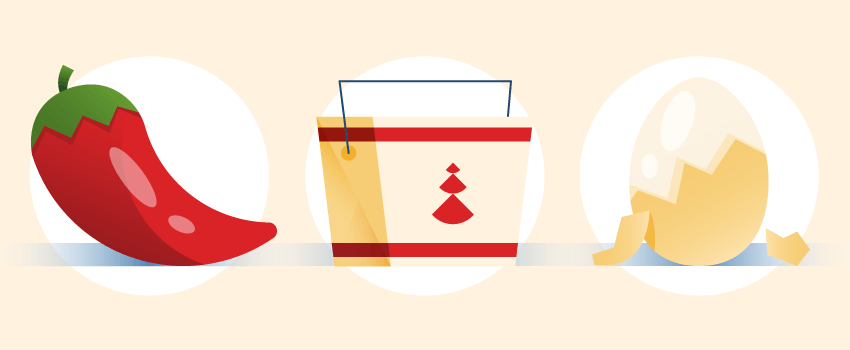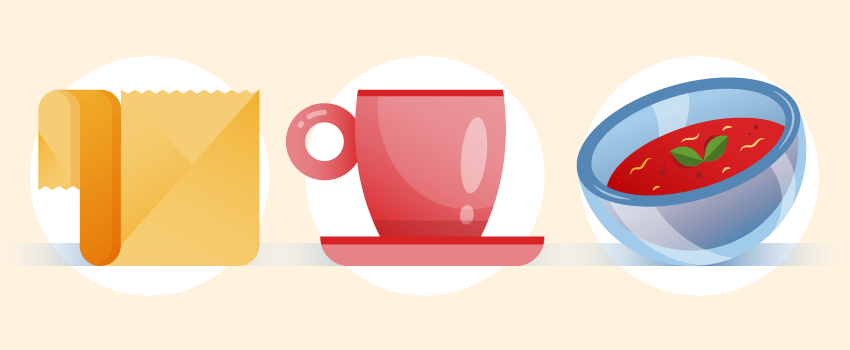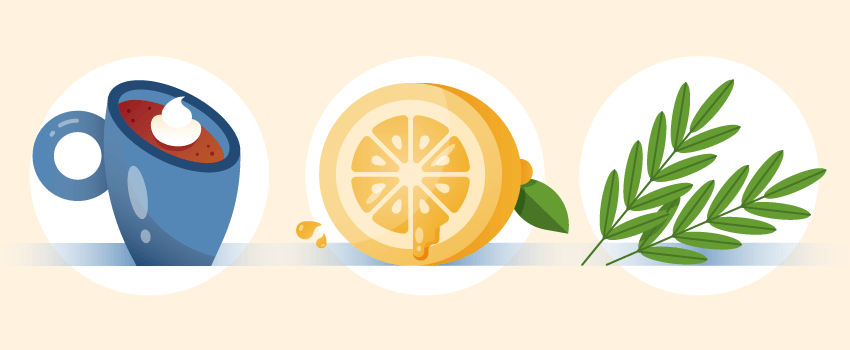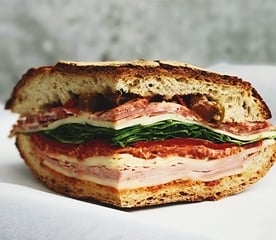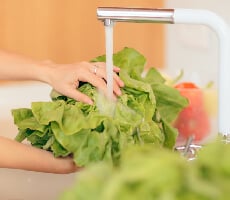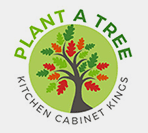When you're strapped for time and need a quick meal, the microwave is an obvious choice. The FDA even notes that “microwave cooking does not reduce the nutritional value of foods any more than conventional cooking.” If this is the case, why do people choose other appliances or fast food when they're in a pinch?
Unfortunately, there's a lot of controversy around what not to put in the microwave, which can lead to confusion and even avoidance of the handy appliance altogether. With this guide, you can head to your microwave cabinet with confidence and scramble your eggs faster than you can decide between pizza or Chinese.
What Happens if You Microwave…
Containers themselves are not heated by microwaves, rather, the residual heat coming from the food warms the dish. This can result in unhealthy chemicals leaching into your food and even damaging your microwave.
When leaching occurs, the microwaves in the appliance are extracting chemicals from the dish or material which are then dissolved in the liquid molecules of your food
What Not to Put in a Microwave
Microwaves are not built to be indestructible, and it's a good idea to keep your heating as simple as possible. Always leave these 27 things out of your microwave.
- China: The metal trim on china can overheat and damage the dish.
- Bread: Bread molecules begin to melt once it reaches a high temperature.
- Single-Use Plastic: Single-use plastics can melt and leave phthalates in your food.
- Breast Milk: Milk heats unevenly and could scald your infant.
- Frozen Meat: You'll be left with half frozen and half-cooked meat.
- Nothing: Running the microwave with nothing in it can ruin the appliance.
- Old Mugs: Some old glazes contain heavy metals and lead.
- Twist Ties: The metal in the ties can spark when heated.
- Uncooked Rice: Bacteria in rice cannot be removed via microwave.
- Cup of Water: This can create superheated water that explodes.
- Food Without a Cover: The high internal temp will likely cause a mess.
- Oil: Oil is a fat, not a liquid, and won't heat properly.
- Hot Dogs: The heated preservatives can spark.
- Travel Mugs: The stainless steel can ruin your microwave.
- Mushrooms: Susceptible to microorganisms, nuking these can make you sick.
- Hard-boiled Eggs: Steam can't escape the egg which can cause an explosion.
- Old Leftovers: There is little nutritional value after nuking leftovers multiple times.
- Hot Peppers: The chemicals released have a similar effect to pepper spray.
- Takeout Box: The metal handle can spark when heated.
- Leftover Potatoes: Excess spore growth could lead to botulism and make you sick.
- Frozen Butter: You'll be left with butter that is half frozen and half-melted.
- Leafy Greens: Leafy greens tend to spark when microwaved.
- Frozen Fruit: The extreme temperature change can create dangerous carcinogens.
- Aluminum Foil: Crinkled foil can spark when microwaved.
- Cookware with Metal: The metal can overheat and damage the dish.
- Yogurt Containers: Single-use plastics can melt and leak phthalates.
- Burned Containers: Once burned, containers release cancer-causing chemicals.
What Can You Put in a Microwave
There are so many caveats to what you can put in a microwave. Sometimes plastic is okay, but other times it's not—but how can you tell? We've answered all your burning questions on microwave safety below.
Can you microwave metal?
You should never heat metal in the microwave. The appliance can only heat the exposed part of food, and won't penetrate metal. When metal is heated, it reflects the microwaves back into the appliance, which causes food to cook unevenly and can possibly damage the oven.
Can you microwave glass?
Glass is typically safe for microwave use. With glass dishes, chemicals will not leach into your food. However, rapid temperature changes, such as taking a frozen dish from the freezer and immediately microwaving it, can cause the glass to shatter.
Can you microwave paper?
Never microwave recycled paper materials. This can include brown grocery bags, newspapers, and take out containers. Not only are these materials unsanitary, but they also may start a fire. Wax paper, parchment paper, and paper plates can be microwaved safely one time, after which should be thrown out.
Can you microwave ceramic?
If a ceramic dish is safe to use in the microwave. Make sure it does not have a metallic trim, and the glaze is not cracked before heating. Ceramic mugs made before the 60's should not be used, as the glaze often contained lead and other heavy metals.
Can you microwave styrofoam?
Check for a microwave safe logo before heating styrofoam. There are two types of this material—one that's safe for microwave use and one that's not. If your styrofoam has melted or warped in any way, do not heat it.
Can you microwave plastic?
Plastic is safe to microwave in some cases. Single-use plastics, such as plastic wrap and takeout containers, are made of thin plastic that will melt when in contact with hot food. When this happens, your food can be contaminated by phthalates, which are not safe for consumption. Stick to thick plastics that have not been warped, scratched, or discolored for microwaving your dishes.
What is the symbol for microwave safe?
How do microwaves cook food?
Microwaves are absorbed by food while passing through materials such as glass, paper, and plastic. The microwave energy produces heat which then cooks the food on the outer layers without contaminating it. Microwaves can enter food up to about 1.5 inches; beyond that, the conduction of heat on the outside of the food cooks the inside.
Microwave Safety Tips
There are some general safety tips you should follow when using your microwave oven at home. Remember to always read the manufacturer's manual for model-specific safety tips.
- Always use microwave safe containers to avoid contaminating food and ruining your appliance.
- Don't use your microwave if the door doesn't firmly shut, this could result in radiation leakage.
- Your microwave should not operate with the door open, but in the rare case that the sensor fails and it continues to operate, report it to the FDA and do not continue to use the appliance to avoid radiation leakage.
- Don't look into or lean on your microwave for extended periods of time. Although cases are extremely rare, burns and cataracts have been reported.
- Clean your microwave regularly with gentle detergent, water, and a soft sponge. When you don't sanitize your microwave, old food particles can contaminate new food that's heated which poses a health risk.
Microwave Hacks
Just because there are some restrictions to cooking in a microwave doesn't mean you should shy away from using this convenient appliance. Beyond reheating your frozen food, use these hacks for quick microwave meals when hunger strikes.
- Cook Your Potato: Poke holes in a potato covered with a wet paper towel, nuke for five minutes
- Save Your Pizza Slice: Avoid chewy pizza crust by adding a cup of water and heating for 30 seconds.
- Ripen your Bananas: Poke holes in the peel of a banana and microwave for one minute to mature a green banana faster.
- Mince Your Garlic: For easy-peel garlic, microwave for 20 seconds.
- Instant Dry Herbs: Heat herbs for 30 seconds, flip, and repeat to dry them.
- Crisp Up Bacon: Nuke bacon for one minute per slice for a tasty breakfast side.
- Make a Quick Cake: Get a mug cake by heating cake mix, sans egg, for one minute.
- Quick Scrambled Eggs: Nuke your egg yolks for three minutes for an easy scramble.
- Soften Lemons: Microwave lemons and limes for 15 seconds to make juicing a breeze.
Whether you use your microwave on a nightly basis, or only use it a few times a year, by avoiding these faux-pas you can safely cook your food and avoid harmful toxins and kitchen fires. Download this graphic and tack it up on the inside of your assembled cabinets next to your microwave for a handy go-to guide whenever you need to nuke something.
Sources: FDA.gov | Harvard.edu | Time.com | Today.com






